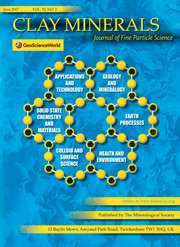Crossref Citations
This article has been cited by the following publications. This list is generated based on data provided by
Crossref.
Nakahira, M.
and
Kato, T.
1963.
Thermal Transformations of Pyrophyllite and Talc as Revealed by X-Ray and Electron Diffraction Studies.
Clays and clay minerals (National Conference on Clays and Clay Minerals),
Vol. 12,
Issue. ,
p.
21.
Rayner, J. H.
and
Brown, G.
1964.
Structure of Pyrophyllite.
Clays and clay minerals (National Conference on Clays and Clay Minerals),
Vol. 13,
Issue. ,
p.
73.
Farmer, V.C.
and
Russell, J.D.
1964.
The infra-red spectra of layer silicates.
Spectrochimica Acta,
Vol. 20,
Issue. 7,
p.
1149.
Mackenzie, R.C.
and
Mitchell, B.D.
1966.
Clay mineralogy.
Earth-Science Reviews,
Vol. 2,
Issue. ,
p.
47.
Farmer, V. C.
and
Russell, J. D.
1967.
Infrared Absorption Spectrometry in Clay Studies.
Clays and Clay Minerals,
Vol. 15,
Issue. ,
p.
121.
Uchiyama, Nobuo
Masui, Iun-ichi
and
Shoji, Sadao
1968.
Crystalline clay minerals of the soils derived from recent volcanic ashes in Hokkaido, Japan.
Soil Science and Plant Nutrition,
Vol. 14,
Issue. 4,
p.
133.
Chute, J. H.
and
Armitage, T. M.
1968.
Alteration of clay minerals by electron irradiation.
Clay Minerals,
Vol. 7,
Issue. 4,
p.
455.
Farmer, V. C.
1968.
Infrared spectroscopy in clay mineral studies.
Clay Minerals,
Vol. 7,
Issue. 4,
p.
373.
Russell, J. D.
Farmer, V. C.
and
Velde, B.
1970.
Replacement of OH by OD in layer silicates, and identification of the vibrations of these groups in infra-red spectra.
Mineralogical Magazine,
Vol. 37,
Issue. 292,
p.
869.
Russell, J. D.
and
Fraser, A. R.
1971.
I.R. Spectroscopic Evidence for Interaction Between Hydronium ions and Lattice OH Groups in Montmorillonite.
Clays and Clay Minerals,
Vol. 19,
Issue. 1,
p.
55.
Ucko, Peter J.
1971.
Part IV STYLISTIC AND TECHNOLOGICAL ANALYSIS.
Archaeometry,
Vol. 13,
Issue. 2,
p.
115.
Tomita, Katsutoshi
and
Dozono, Mitsuhiko
1972.
Formation of an Interstratified Mineral by Extraction of Potassium from Mica with Sodium Tetraphenylboron.
Clays and Clay Minerals,
Vol. 20,
Issue. 4,
p.
225.
Ertem, Gözen
1972.
Irreversible Collapse of Montmorillonite.
Clays and Clay Minerals,
Vol. 20,
Issue. 4,
p.
199.
1974.
The Infrared Spectra of Minerals.
p.
331.
Farmer, V. C.
and
Palmieri, F.
1975.
Soil Components.
p.
573.
Mackenzie, R. C.
1975.
Soil Components.
p.
1.
Mackenzie, R. C.
and
Caillère, S.
1975.
Soil Components.
p.
529.
Rai, Hideki
and
Yamada, Junkichi
1975.
Preparation of Reinforcing Fillers from Japanese Acid Clays with Lime and by Calcination. III. Elucidation of the Reinforcing Effects Based on the Investigation of Changes in the Structure, Physicochemical Properties and Morphology of N Hard Clay.
Bulletin of the Chemical Society of Japan,
Vol. 48,
Issue. 5,
p.
1621.
Mackenzie, R. C.
1975.
Physicochemical Methods of Mineral Analysis.
p.
389.
Rai, Hideki
and
Yamada, Junkichi
1976.
Preparation of Reinforcing Fillers from Japanese Acid Clays with Lime and by Calcination. IV. Investigation on the Structure, Physicochemical Properties and Morphology of M Hard Clay in Relation to the Reinforcing Effect.
Bulletin of the Chemical Society of Japan,
Vol. 49,
Issue. 3,
p.
796.

